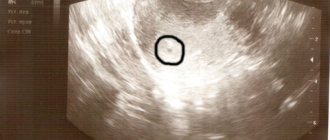Fetal Doppler is a diagnostic procedure that assesses the state of blood flow in the vessels that provide nutrition to the developing fetus during pregnancy. With the help of this diagnosis, the doctor can identify pathologies that impede the full development of the child.
It is recommended to sign up for Doppler testing during pregnancy in the NEARMEDIC network of clinics: modern ultrasound equipment, attentive and competent doctors, quick interpretation of the results are the main advantages of contacting us.
The main differences between Doppler ultrasound and ultrasound
The method of carrying out such diagnostics is similar to the well-known ultrasound examination. A gel is applied to the woman’s skin, after which the doctor moves a sensor over the abdomen, and the image is simultaneously displayed on the computer screen. The main difference from ultrasound is that Doppler ultrasound uses color Doppler mapping. This mode is available in all modern ultrasound machines.
On the screen, the doctor will determine the speed of blood circulation in the vessels of the umbilical cord and uterine vessels. The speed of blood movement is displayed on the monitor in the form of curves. The doctor enters a numerical value into the protocol.
Doppler testing during pregnancy
Doppler ultrasound can be performed from the second trimester, in particular from the 20th week of gestation. Typically, at such relatively early stages, Doppler is prescribed if fetal development is suspected, if there have been previous miscarriages or missed pregnancies, or if there are other pathologies of pregnancy.
At 30-34 weeks, Doppler testing is a mandatory study, and its results are included in the protocol of the third ultrasound.
A simple Doppler allows you to evaluate only one functionality of a blood vessel - its patency, that is, how much blood flow passes through the vessel in a certain period of time.
Triplex study
A triplex study is a study that evaluates not only the patency of the vessel, but also identifies the causes of its violation. The main reasons include stenosis, the formation of a blood clot in a vessel, and the presence of plaques. Triplex allows you to see a color image of blood vessels on the screen and study their anatomy in detail.
When is Doppler testing prescribed?
The study is indicated for women in the third trimester of pregnancy to assess the speed of blood circulation and timely development of the fetus. Indications for the mandatory procedure are:
- Preeclampsia.
- Too little or too much amniotic fluid.
- Fetoplacental insufficiency.
- The presence of chronic and severe pathologies in the mother (diabetes mellitus, anemia).
- Rhesus conflict between mother and child.
- Multiple pregnancy.
- Incorrect placement of the fetus in the uterus.
- The umbilical cord is entwined around the fetal neck.
- Premature formation of the placenta.
- Presence of abdominal injuries in a pregnant woman.
- Diagnosed chromosomal pathologies of the fetus.
- Complications that were observed during a previous pregnancy.
- Hydrops fetalis.
DOPPLEROMETRY OF UROPLACENTAL, FETAL-PLACENTAL AND FETAL BLOOD FLOW
Doppler ultrasound is an ultrasound examination that can be used to detect disturbances in blood flow in the vessels.
Studies of utero-placental blood flow in the uterine arteries and fetal-placental blood flow in the umbilical cord artery have the greatest practical value during pregnancy; as well as fetal hemodynamics in the aorta and cerebral vessels of the fetus. Currently, an important diagnostic method is the study of venous blood flow in the fetus in the ductus venosus.
INDICATIONS FOR DOPPLER METRY DURING PREGNANCY
The main indications for Doppler study of blood flow in the “mother-placenta-fetus” system are extragenital diseases and complications of pregnancy: hypertension, hypotension, kidney disease, collagenosis, vascular diseases, diabetes mellitus, preeclampsia, fetal growth restriction or post-term pregnancy, oligohydramnios, polyhydramnios. , multiple pregnancy, resusensitization, etc.
| Blood flow in the uterine artery | Blood flow in the umbilical cord artery | Blood flow in the fetal MCA |
Information for specialists
Dynamics of Doppler studies in various obstetric situations
When assessing blood flow in the uterine arteries, the pulsatility index (PI>1.2) and the presence or absence of a dicrotic notch at the beginning of diastole are used. When assessing resistance in the uterine arteries, scoring criteria (UAS) are used. Select 4(UAS). UAS 0 – normal blood flow in both uterine arteries UAS 1 – presence of one pathological blood flow parameter (PI>1, 2 or the presence of a notch) UAS 2 – presence of two pathological blood flow parameters UAS 3 – presence of 3 pathological blood flow parameters UAS 4 – presence of pathological blood flow in both uterine arteries (PI>1, 2 and presence of notch)
When assessing blood flow in the umbilical cord arteries, the values of the pulsatility index and the presence or absence of diastolic blood flow are used. There are four types of blood flow (BFC) BFC 0 - normal blood flow in the umbilical cord arteries BFC 1 - PI greater than 2-3 standard deviations, diastolic blood flow is preserved. BFC 2 - PI greater than 3 standard deviations, diastolic blood flow is preserved BFC 3A - zero diastolic blood flow in the umbilical cord artery BFC 3B - reverse diastolic blood flow in the umbilical cord artery
Suspicion of intrauterine growth retardation
In the absence of abnormalities in the umbilical cord artery and BMD disorders: If the weight deviates from 22-27%: - type 0-2 - Doppler measurements once every 2 weeks; — type 3 – Doppler once a week; — type 4 – Doppler 2 times a week; Fetometry once every 2 weeks
In the absence of abnormalities in the umbilical cord artery and uterine arteries - deviation in weight from 28-34% - Doppler measurements 2 times a week; - weight deviation of 34% or more - Doppler measurements 2-3 times a week; Fetometry once every 2 weeks
In the presence of disturbances in the umbilical cord artery and the absence of disturbances in the uterine arteries - type 1 - Doppler and CTG 2 times a week; -type 2 - Doppler and CTG 3 times a week; -type 3A - resolve the issue of hospitalization and delivery. For a period of less than 34 weeks - Doppler measurements daily, CTG 2 times a day. - type 3B - emergency delivery, with a period of less than 26-27 weeks - decision of the council. Fetometry once every 2 weeks.
Clinical management of patients with a normal pregnancy and normal blood flow in the umbilical arteries, but with signs of increased resistance in the uterine arteries. UAS 0-1 - routine outpatient observation UAS 2 - outpatient observation, Doppler monitoring once a month UAS 3 - if dynamic ultrasound shows no changes in the dynamics of fetal growth - Doppler monitoring once a month; if the dynamics in weight changes from 9 to 10% - Doppler measurements and fetometry once every 2-3 weeks UAS -4 - Doppler measurements weekly, fetometry once every two weeks.
What can Doppler testing reveal?
With the help of the study, it is possible to determine the child’s hypoxia and take measures to minimize the consequences of lack of oxygen. Doppler testing allows you to see the reasons for the umbilical cord entwining the baby’s neck and choose the right tactics during the birth process.
In addition, diagnostics allows you to evaluate:
- Blood circulation speed of the peripheral circulatory system.
- Blood circulation in the area of the umbilical cord, fallopian tubes.
- The condition of the vascular bed, deviations that block blood flow.
- Functioning of the placenta.
What is Doppler ultrasound (USD) of the fetus?
The procedure is necessary to assess the condition of the fetus
and determine whether he is receiving enough oxygen. Based on the results of such a study, it will become clear whether there are any deviations and whether complications are possible during pregnancy.
Dopplerography in general is based on the fact that sound waves are reflected from moving objects in a completely different way than from stationary ones. Blood is a heterogeneous mixture of plasma and cells that are in constant motion, due to which the Doppler effect is applicable to them. Ultrasound scanning during pregnancy allows you to determine at what speed the blood moves through the vessels, what is the direction of its movement, as well as how intense the blood flow is. These indicators allow us to judge the size of the blood vessel and its diameter.
Preparation and features of the event
No special preparation is required for the study; on the eve of the procedure, you can lead your usual lifestyle. It is recommended to refrain from eating a couple of hours before the examination.
Diagnosis is similar to a regular ultrasound. The woman undresses to the waist and lies down on the couch, after which a gel is applied to the area being examined (the abdomen) for better skin contact with the sensor. Next, the specialist moves a sensor over the abdomen and studies the information on the screen. A transcript can be obtained from our network of clinics on the same day.
With Doppler, color mapping can be used, which allows you to determine the condition of even small vessels (their patency is marked with a certain color on the screen).
When are pregnant women prescribed Doppler ultrasound of the fetus?
Carrying out ultrasound examination during pregnancy has certain norms and deadlines. Diagnosis is possible from 16 to 20 weeks of pregnancy - at this time the placenta is already formed. The examination is included in the screening program in the third trimester of pregnancy - 30-34 weeks. Sometimes the procedure can be scheduled a little earlier, at 20-24 weeks.
Arterial hypertension
During pregnancy, Doppler may be prescribed if high blood pressure is detected. This phenomenon in itself is extremely undesirable, since it can threaten the health of both the expectant mother and the baby. Delayed diagnosis can cause the development of failure of the cardiac and renal systems, strokes, heart attacks, and vision disorders.
Threat of miscarriage or premature birth
Premature birth and termination of pregnancy are the most dangerous conditions, since a woman can lose her child. This can be prevented by ultrasound examination during pregnancy (what it is was said above) and assessment of the state of the blood supply to the placenta and blood vessels as a whole, as well as the doctor’s decision-making based on the receipt of the necessary information.
High degree anemia
Anemia is caused by low iron levels in the blood, as a result of which red blood cells cannot cope with providing oxygen to tissues. In this case, an ultrasound scan is necessary to examine the fetus.
and identifying the baby’s health status. The child will first suffer from an acute lack of oxygen. If we are talking about grade 2 anemia, its treatment should be immediate and carried out exclusively in a hospital setting.
Large uterine fibroids
During pregnancy, an ultrasound scan may be prescribed due to the fact that uterine fibroids have been identified. The neoplasm itself is benign and does not pose a threat to the life and health of the woman and fetus. The danger is that fibroids can begin to collapse at any time, and pregnancy provokes an increase in the nodes. However, in many patients, pregnancy in the presence of small fibroids proceeds normally.
Infection of the genital area
Ultrasound scanning of the fetus is extremely necessary when detecting infectious diseases. Such infections can provoke various developmental abnormalities, so careful monitoring of the health of both the woman and the fetus is necessary.
Decryption features
The specialist evaluates the following indicators:
- Systole-diagnostic ratio (ratio of maximum and minimum blood circulation velocity).
- Pulsation index. The ratio of the difference in the values of the minimum and maximum blood circulation speed to the average speed for the full cycle of the heart.
- Resistance index. The ratio of the difference in the values of the minimum and maximum blood circulation speed to the maximum during compression.
Only a specialist should decipher the results. In the NEARMEDIC network of clinics, you can sign up for Doppler ultrasound followed by a consultation with a competent obstetrician-gynecologist. Sign up for Doppler testing by phone or through the form on the website.
Still have questions?
Fill out the form and our specialist will contact you.
Preparing for the study
It is necessary not only to find out the norms of Doppler ultrasound during pregnancy
, but also decide how to prepare for the procedure. It is worth knowing that there is no need to carry out any special preparatory procedures - just sign up for a diagnosis and come to the doctor. The only thing worth taking care of is having a napkin with which you can remove the remaining gel after the diagnosis is completed. Doppler ultrasound examination is not much different from a regular ultrasound examination; the doctor will simply conduct the scan in two modes.
What is being studied
Brachiocephalic arteries and vessels of the cervical spine
Vessels of the brain and vertebral arteries
Veins and arteries of the lower extremities
Veins of the upper extremities
Aorta, iliac vessels.
Indications and contraindications
The main indications for examination include the following:
- osteochondrosis;
- suffered a stroke;
- vegetative-vascular dystonia;
- diabetes;
- hypertension;
- ischemic disease;
- phlebeurysm;
- risk of blood clots;
- excess body weight.
As for contraindications for this procedure, there are virtually none, since ultrasound examination is considered safe for health. However, the temporary limitation for the technique is acute inflammatory diseases.
Preparation and execution
The advantage of the technique is that it does not require special preparation from the patient.
The only limitation is taking vascular medications, which it is advisable to stop 2-3 days before diagnosis. You should also avoid smoking and alcohol. During an ultrasound scan, the patient lies down on the couch and removes the desired area of the body from clothing. Next, a special conductive gel is applied and the sensor is applied to the skin. By moving this sensor, the doctor conducts a study, recording the necessary data in the process and taking pictures of the resulting images.
What is Doppler?
Today, ultrasound diagnostics of the fetus is rightfully considered the most informative examination during pregnancy. Thanks to ultrasound, it has become possible to monitor the growth and development of the baby in the womb, identify defects and anomalies in the early stages, prevent the risks of miscarriages, as well as dangerous complications that threaten the health of the fetus and the expectant mother. In addition to the standard three ultrasound scans during pregnancy, obstetricians-gynecologists prescribe additional ultrasound examinations of the fetus. One of them is Doppler ultrasound.
Fetal Doppler is an ultrasound examination that allows diagnosing blood flow in the circulatory system connecting the unborn baby, the placenta, the umbilical cord and the body of the pregnant woman. Based on the results of Doppler testing, the doctor assesses the state of the fetal blood flow through the vessels and arteries and can identify deviations in their development, a lack of oxygen supply, and so on. The examination is also of particular importance for the diagnosis of fetoplacental insufficiency in cases of delayed fetal development, gestosis, dysfunction of the placenta and other pathologies of pregnancy.
How is Doppler ultrasound done?
Fetal Doppler testing is no different from screening ultrasound. The expectant mother is asked to bare her belly and lie down on the couch. The doctor applies gel to the skin of the abdomen and begins to move the sensor, examining the parameters in the correct scanning plane. The procedure does not require specific preparation and is absolutely painless. Diagnostics takes 20-40 minutes. Upon completion of the procedure, the woman is given a conclusion.
Diagnostics are carried out using an expert-class device Mindray DC-7 .











